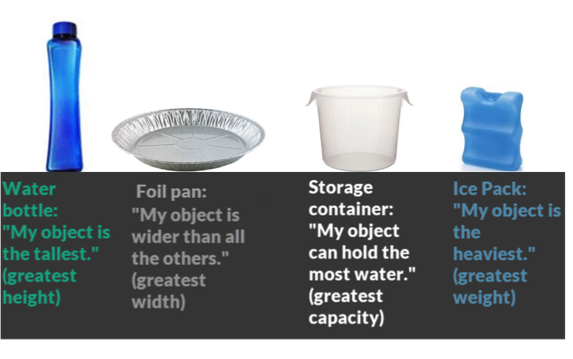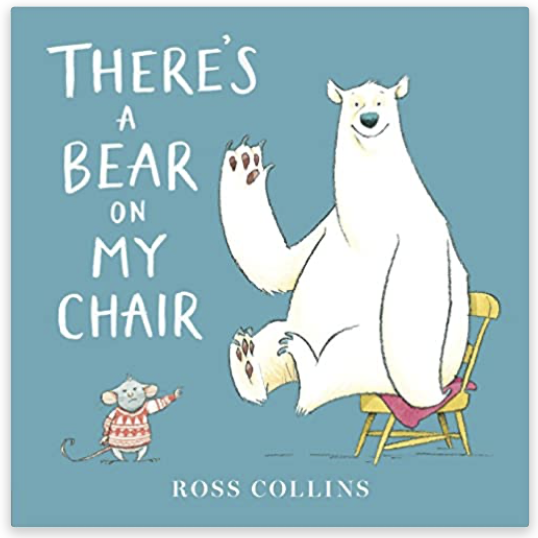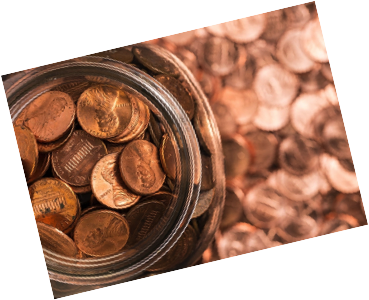This resource is designed to engage your participants in learning about measurement. Notions of big and little and biggest and littlest permeate children's play and preschool learning. However, deciding which object is biggest or littlest depends on which attribute (height, width, capacity, or weight) a child is considering. In this activity, participants are given various objects and asked to make a case that their object is "the greatest" in some way.
Materials Needed
Each group will require four common household objects, each the greatest based on a certain attribute. (Examples are shown, but you can choose other objects.):
● one object is tallest (empty water bottle with a lid)
● one object is widest (foil pie pan)
● one object has the greatest capacity (food storage container)
● one object is heaviest (ice pack)
In addition, provide each group with a container full of water or sand (preferably on a tray to reduce mess), as well as a measuring cup or other scooping device.
Activity
This activity was inspired by classroom work described in the Early Math Collaborative's Big Ideas of Early Mathematics (2014). The book describes children comparing objects at a sand table in different ways, based on different attributes.
Have participants work in groups of four (or as close to that number as possible). Give each group a set of four objects as described above. Choose objects that are only "the greatest" in terms of a single attribute or dimension. For example, when choosing an object to be the tallest, be sure it does not also have the greatest width, capacity, or weight.
Explain that young children are often good-naturedly competitive in everyday life. For example, one child may say that her tower is the biggest of all and another may say that his knapsack is heavier than another child’s. These kinds of comparisons can be used to help children develop ideas about measurement and learn language for comparing objects. Therefore, this activity involves several kinds of comparisons of the sort that children might make.
Allow participants to handle and consider each of the four objects. Then assign an object to each participant. Explain that each participant will claim that "my object is the greatest," and must then make a case for why their object is the greatest, based on one of its attributes. Explain that participants can line up the objects, handle the objects, or use the available sand or water to fill them to help them develop and make their cases.

After participants have had time to come up with a rationale, have each participant present their objects to the others in their small group and briefly say why their object is the greatest. For example, here are some, but not all, of the arguments that participants could make.
After participants have made their cases, encourage them to discuss other attributes of the objects. For example, the participant with the foil pan might say, "My pan doesn't have the greatest capacity, but I think it has the second greatest capacity." Other students might use the sand or water to change an attribute of their objects. For example, a participant might say, "The water bottle is the tallest, but if I fill it with sand, I think it will also be the heaviest." Encourage participants to discuss within their small groups different ways to measure, manipulate, and compare the objects.
Discussion/Reflection
Meet back as a whole group to discuss what participants learned from the activity. Below are some possible discussion questions that can be used to follow up after the activity:
- What did you think of this activity? Why do you think I presented it to you?
- Did anything surprise you? (Some participants might say that they had not considered having young children think about capacities or weights, not just lengths, when teaching about measurement.)
- Was it easier to make a case for some objects than others? (For example, the taller object is visibly taller than the others, yet one would have to pour sand or liquid into it to prove that the food storage container had the greatest capacity.)
- Do you think an activity like this could be used in an early childhood classroom?
- Which attribute(s) would you expect a young child to pay the most attention to? (Participants may point out that many children may be most interested in the attribute of height, because that is a very important attribute about the children themselves.)
- Do you think young children would struggle to understand that one object can be both the greatest and the least? (For example, the water bottle has the greatest height but also has the least width of any of the objects. The pie pan has the greatest width, but the least height.)
- Could there be an object that could be greatest in either of two ways depending on how you orient it? (In other words, something is tall if held up and wide if placed horizontally?) How do you think a young child would deal with that?
- Can you think of other ways to modify this task? (For example, would you consider providing an object that is "the greatest" in more than one way at once, such as the tallest and also the heaviest?)
Ask the participants to revisit the activity after the session by reflecting on their experiences in writing. Use their responses to shape your own teaching.
Extension
You can extend this activity by showing how a picture book can be used to develop children's understanding of measurement (handout available here)
Sarama, J., & Clements, D. H. (2009). Early childhood mathematics education research: Learning trajectories for young children. New York: Routledge.



